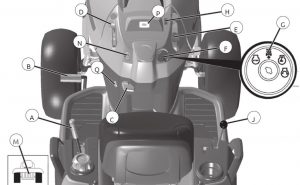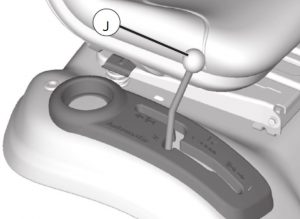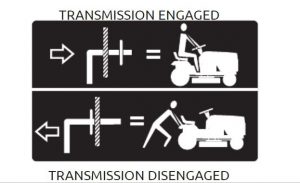Troubleshooting
Lawn mowers are outdoor tools that spend a considerable amount of their operational time outdoors in harsh environmental conditions that can often include dust, high temperatures and humidity. As a result of indiscriminate exposure to these elements, the machines can run into occasional problems from time to time. However, Husqvarna’s line of mowers are robustly engineered for heavy-duty use and most of the issues that you run into will be minor problems that can be fixed right from your garage without having to visit a service center. However, if you are not experienced with working on power tools, do not hesitate to take the unit to an authorized service center to get it checked by a professional. Always remember that the mower must only be worked on by a licensed technician.
Husqvarna lawn mowers are very reliable machines and most probably you won’t need to take the machine to the service or troubleshoot yourself. To make sure that your lawn mowers works propely you need to perform basic maintenance activates listed in the table below
Table 1 Maintenance works schedule applicable for all Husqvarna models
| Time Frame | Task |
| Daily | Clean out accumulated debris and clippings |
| Check that brakes are working properly | |
| Inspect tire pressure | |
| Check the safety operator presence system’s functionality | |
| Every 25 hours | Sharpen or replace the blades |
| Lubricate the necessary components as per the chart | |
| Check the battery level | |
| Clean out the battery terminals | |
| Inspect the transaxle coolant and refill if necessary | |
| Change the engine oil | |
| Clean out the air screen | |
| Clear the engine’s air filter | |
| Every 50 hours | Check the deck and mower height for adjustments |
| Change the engine’s oil filter | |
| Check the system’s muffler and spark arrestor | |
| After 100 hours | Replace the spark plug |
| Inspect the v-belts and replace if necessary | |
| Clean out the cooling fins on the engine | |
| Replace the filter’s paper element | |
| Each season | Recalibrate or replace the spark plug as required |
| Replace the filter’s element or change the filter |
Ensuring safety is your priority –
Before you use your mower for the first time, it’s absolutely imperative that you go through all the instructions in the provided user manual and learn all about the workings of your lawn mower. Never compromise your safety or that of others to start mowing immediately. Lawn mowers are powerful cutting tools that can cause serious damage or inflict grievous injuries if not used with adequate responsibility.
- Always wear heavy-duty shoes, trousers, gloves, and hearing protection when operating the mower.
- Ensure that the engine is regularly serviced with oil levels and other fluid levels up to the marked level.
- Inspect the mowing area prior to mowing and remove any potential obstacles, toys, rocks, or other objects that may get thrown by the mower’s blades.
- Ensure that there are no children or pets in the area to be mowed.
- Learn all the controls and functions of each switch before using the mower. It’s especially important that you know how to engage the emergency brake.
- Only use high quality fuel to run your mower to improve the longevity of the mower’s engine. If fuel has not been used for a long period, dispose of the stale gasoline in a safe manner before refueling with fresh gas.
- Exercise caution at all times when using the mower, especially when mowing over inclined surfaces and rough terrain.
- Ensure that you change the blade as often as required. Inspect the condition of the blade after each mowing session.
- If the mower strikes any obstacle while mowing your lawn, stop the machine immediately and inspect the condition of the blades.
- Do not use the mower in unsuitable conditions including badly lit areas, on damp or wet grass, in the rain or other similar conditions.
- Use only genuine parts that are specifically meant for your mower’s model.
- Never leave the mower running when you need to leave the unit for any length of time.
- Ensure that you slow down enough before approaching a hill. As far as possible, try to avoid steering too much on sloped surfaces.
- Never allow children to ride on the mower with you during a mowing session.
- Clean the machine’s deck and blades at the end of each mowing session to prevent debris from accumulating on the machine.
In the table below we have listed most common issues and troublehooting methods. Remember to ensure safety before starting any work. If not sure transport your mower to authorized local service
Table 2 Most common issues and its solutions applicable for all Husqvarna mowers
| PROBLEM | POSSIBLE CAUSE | SOLUTON |
| White smoke coming from mower | Oil may have spilt around the unit after servicing | Wipe off any excess oil drips |
| Too much friction within the mower | Clean the inside off the mower and ensure there are no accumulated clippings. | |
| Mower not moving straight | Tires are not uniformly filled | Fill all tires with equal pressure |
| Steering mechanism is loose | Recalibrate the steering mechanism | |
| Unable to get the engine to start | Low quality fuel has been used | Refill the fuel tank with fresh gasoline |
| Choke settings in the engine are not properly adjusted | Refer to the engine manual to choke properly | |
| Spark plug needs to be replaced | Clean or replace the spark plug with a new one | |
| Fuel filter may be clogged or dirty | Remove the old fuel filter and fit a new one | |
| Mower stalls after starting | Fuel filter may be clogged or dirty | Remove the old fuel filter and fit a new one |
| Spark plug needs to be replaced | Clean or replace the spark plug with a new one | |
| The mower’s battery may have run out of charge | Recharge or replace the battery | |
| Low quality fuel has been used | Refill the fuel tank with fresh gasoline | |
| Wiring might be loose or damaged | Inspect and repair the wiring if necessary | |
| Engine doesn’t turn over | The clutch pedal might not be depressed all the way down | Press down the clutch with your foot |
| Attachment clutch may be left activated | Deactivate the attachment clutch | |
| Fuse might have blown | Replace any blown fuses | |
| Battery terminals may be dirty | Clean out the battery’s terminals | |
| Ignition switch may be damaged | Replace the ignition switch if required | |
| Solenoid or starter is damaged | Replace the solenoid if required | |
| Engine losing power | Grass height may be too high for deck | Increase the deck height |
| Cutting wet grass | Wait for the grass to completely dry | |
| Throttle must be in the incorrect choke mode | Adjsut the throttle as required | |
| Air filter might be dirty | Clean the air filter or replace it if necessary | |
| Water might have mixed with the fuel | Discard fuel and refill with fresh gasoline | |
| Air screen might be clogged or dirty | Clear out debris from the air screen | |
| Mower does not go into reverse | Reverse operation system has not been enabled | Engage the reverse operation system by activating the ignition of the mower |
| Engine backfiring when turned off | Throtte speed not appropriately set | Set the throttle to the right speed |
| Blades not rotating | Clutch system might be jammed | Remove the obstruction from the clutch |
| Drivebelt could have worn out | Fix the drive belt or replace it | |
| Blade mandrel might be bent | Relpace the mandrel or shaft | |
| Idler pulley may have frozen | Replace with a new pulley |
Identifying the various switches and controls on the Husqvarna Lawn Mower –

- A) Attachment lifting mechanism: This lever can be used to activate the lifting mechanism that raises or lowers contraptions such as the cutting deck which are attached to your mower.
- B) Brake pedal: This pedal is used to lower the ground speed of the mower while moving, and also for starting the engine.
- C) Parking pedal: This pedal is used to lock the primary brakes and the clutch to park the mower and prevent it from moving
- D) Throttle control: This control switch is used to increase or decrease the ground speed of the lawn mower
- E) Attachment clutch switch: This switch is used to activate the contraptions that have been attached to the lawn mower, such as the cutting blades of the cutting deck.
- F) Ignition switch: This switch is used to turn on the mower’s engine and to turn it off.
- G) Reverse operational system switch: This switch can be used to allow the mower as well as its attached contraptions to operate in the reverse direction.
- H) Light switch: This switch is used to switch on the main headlights and switch them off.
- J) Motion control lever: The motion control lever is used to choose the lawn mowers direction as well as speed.
- M) Freewheel control: This control may be engaged when the tractor needs to be towed at low speeds, by deactivating the transmission mechanism.
- N) Choke control: The choke control is ideal for starting an engine in colder conditions.
- P) Service reminder: This indicator may be used to check when the lawn mower is due for another periodic service.
Operation of the lawn mower –
Engaging and disengaging the parking brake:
The lawn mower has an operator detecting technology inbuilt within the system to help it determine the presence or absence of a person in the driver’s seat. If the person attempts to get off the unit without first properly engaging the parking brake, the engine has been designed to automatically shut off for safety reasons. To engage the parking brake, depress the primary brake pedal (B) until it has been lowered all the way to the ground. Now, with the brake pedal still held firmly down, pull up the primary brake lever (C) towards you and then release the brake pedal. Once released, the parking brake should firmly hold in place. If the parking brake has not been properly activated, ensure that you follow the above process again to securely park the mower.

Stopping the mower:
In order to bring the mower’s blades to a halt, pull the attachment clutch control to the marked ‘disengaged’ setting. To bring the main mower unit to a stop while travelling in the forward direction, gradually engage the brake by depressing the brake pedal until the mower slows to a stop. Once the mower has been brought to a complete halt, gradually move the main motion control lever onto the neutral marking. It’s important to remember that the engine throttle switch must be move down between the half and full-speed markings before you bring the mower to a complete stop in order to prevent the engine from backfiring. Now you may turn the key to the stop position and remember to remove the key when leaving the mower unattended. Do not use the choke switch to bring the engine to a stop.
Using the throttle control and the choke:
To ensure that you get the best cutting experience and do not under power the engine, ensure that the engine is always set to the full speed. To set the speed of the engine to the maximum, slide the throttle control lever (D) all the way up – this ensures the engine is delivering optimum performance. The choke control switch is only to be used when the engine is cold and is not to be used to start a warm engine as it could damage the engine.

Moving in the forward and backward directions:
The main motion control lever can be used to set the direction of the mower as well as adjust the speed of motion in either direction. First ensure that the mower is only started with the motion control lever in the neutral setting. Gradually release the brake after this and you can initiate movement by sliding the motion control lever to the desired position. Remember that the speed of the mower must never be increased or decreased abrupting. Also, it is highly recommended that the mower’s speed in not changed drastically while turning or mowing on inclined surfaces. To stay safe, aim to mow at the slowest possible speed while travelling on an inclined surface.

Adjusting the cutting height:
The lift attachment lever may be used to control the height of the primary attachment and raise or lower its position. Depending on the type or condition of the ground you will be mowing, it may be necessary to raise or lower the height of the mower. Remember that while cutting very tall grass, it is recommended that you complete the cut first at the maximum possible height setting and then decrease the height to the desired setting and mow the area once again. To adjust the height of the cutting deck, simply slot the lever into the desired cutting height’s position.

Transporting the lawn mower –
When transporting the mower to a new location, firstly ensure that the fuel tank has been completely drained and the unit is in the off position. For safety reasons, it is only highly recommended that the spark plug assembly is disconnected. Now raise the cutting deck to the maximum possible setting and then set the transmission to the disengaged setting by activating the freewheel mode of the lawn mower. This will deactivate the transmission gears and allow free motion of the mower’s wheels even with the engine turned off. However, it’s important that you ensure the mower is only pushed at a low speed no greater than 2 mph. Also ensure that all seals and hoods have been securely closed before transport.